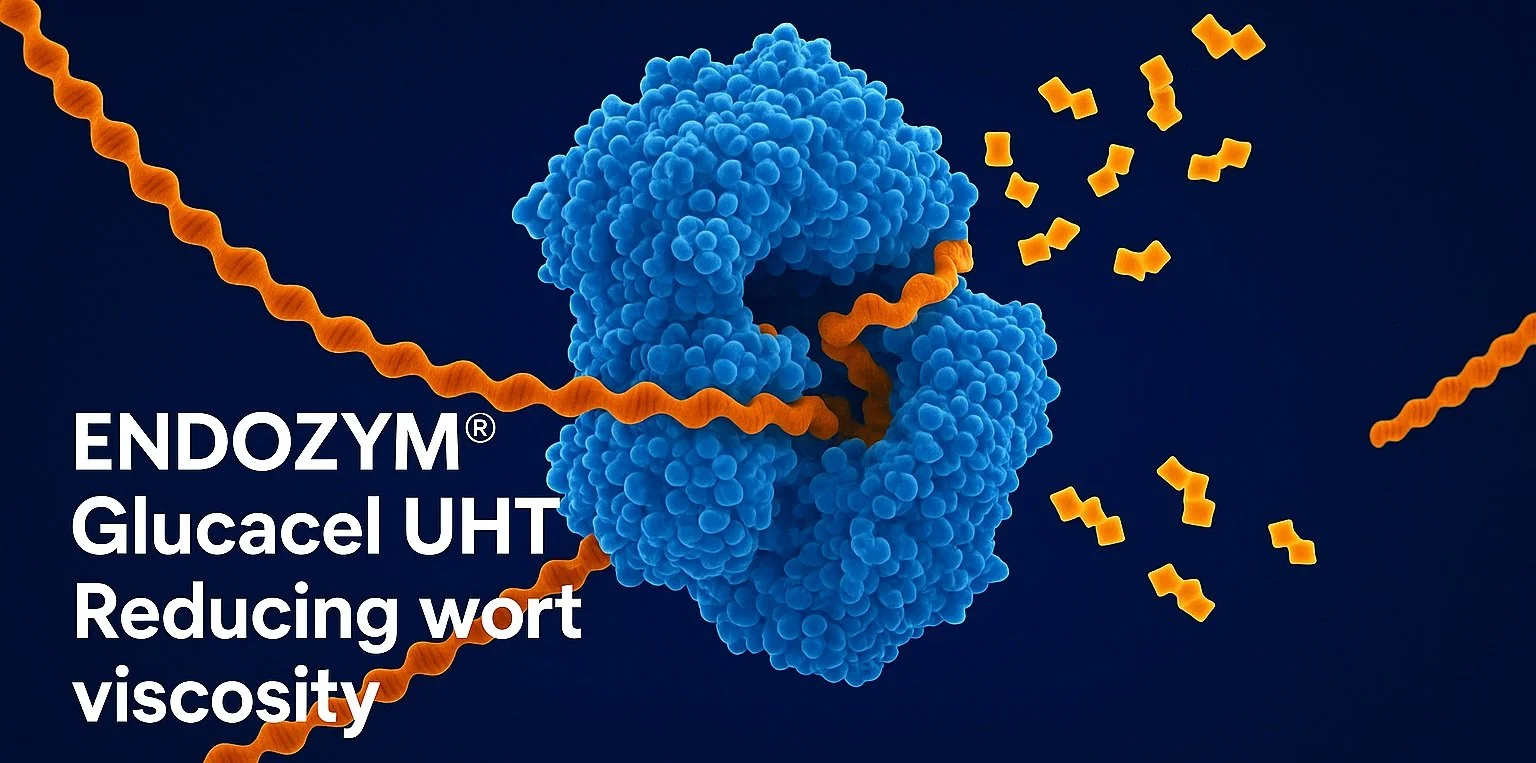High adjunct use and high-gravity mashes can present significant challenges in the brewhouse. Elevated levels of wort β-glucans and other non-starch polysaccharides from barley and adjunct cereals can lead to increased viscosity, slow lautering, and lower extract yields. ENDOZYM® Glucacel UHT is a beta-glucanase enzyme preparation designed to tackle these issues by breaking down these viscous cell-wall compounds in the mash. Brewers can employ this specialised enzyme to improve mash filterability and optimise brewhouse efficiency even with adjunct-rich or high original gravity (OG) recipes. The typical dosage rate is 20–30 mL per 100 kg of malt, recommended for addition during mashing; however, the optimal rate may vary depending on the grist composition and mashing profile.
Functional Role in the Brewing Process
By enzymatically cutting viscous β-glucans and hemicelluloses into shorter, more soluble pieces, Glucacel UHT provides several key benefits for the brewing process:
Lowers wort viscosity, resulting in a smoother flow of wort, enabling faster and more efficient wort separation (improved lautering and filtration).
Improves mash filterability, particularly when using high adjunct percentages or under-modified malts that release excess gums.
Boosts extraction efficiency by freeing up additional fermentable extract that might otherwise remain trapped in the grain bed.
Optimise brewhouse throughput by shortening mash separation times and preventing process bottlenecks, resulting in more brews per day or shorter production cycles.
The data presented in this chart is illustrative and not derived from a controlled experimental study. Time estimates are based on typical mash separation ranges observed in brewhouses using high-adjunct recipes and reflect expected outcomes when using ENDOZYM® Glucacel UHT, as described in product literature and technical data. Actual performance may vary depending on specific brewing conditions, equipment, and raw materials.
Enzymatic Composition
ENDOZYM Glucacel UHT consists of a concentrated blend of cell-wall-degrading enzymes: primarily β-glucanase and xylanase, with a minor cellulase side activity. This composition targets the principal viscous polysaccharides in brewing grains – β-glucans (from barley β-glucan) and pentosans (arabinoxylans) – with a small cellulase activity to tackle residual cellulose. The enzyme blend is produced from selected fungal strains (Aspergillus niger and Trichoderma reesei) via fermentation. These filamentous fungi are well-known industrial sources for brew-relevant enzymes; they secrete high levels of cellulolytic and hemicellulolytic enzymes during controlled cultivation.
Barley malt and adjunct cereals contain significant amounts of β-glucan and arabinoxylan in their cell walls (roughly 70% and 20% of the cell-wall polysaccharides, respectively). By including both (β-glucanase and xylanase) ENDOZYM Glucacel UHT can effectively hydrolyse these viscosity-causing polymers. The minor cellulase activity provides further breakdown of any cellulose fibrils or other cell-wall components, ensuring a more complete reduction of mash viscosity.
Ana Victoria Vasquez de la Peña
ana@neumaker.com.au
19 May 2025
© 2025 neumaker. All rights reserved. This article may be shared/forwarded for personal or educational purposes, provided it remains unaltered and includes proper attribution. Reproduction, distribution, or use in any other form—including but not limited to commercial purposes, republishing, or adaptation—without explicit written permission is strictly prohibited.
References:
AEB Group. (2023). ENDOZYM® Glucacel UHT – Technical Data Sheet (Australia). AEB Oceania Pty Ltd. https://www.aeb-group.com
Briggs, D. E., Boulton, C. A., Brookes, P. A., & Stevens, R. (2004). Brewing: Science and practice. Woodhead Publishing.
Ilett, S. M., Jobling, S. A., & Bacic, A. (2016). Cell wall polysaccharides and polysaccharide-degrading enzymes in barley: Implications for the malting process. Scientific Reports, 6, 33215. https://doi.org/10.1038/srep33215
Bamforth, C. W. (2003). Barley and malt starch, enzymes, and the brewhouse. Journal of the Institute of Brewing, 109(4), 259–266. https://doi.org/10.1002/j.2050-0416.2003.tb00168.x
Evans, D. E., Collins, H., Eglinton, J., & Wilhelmson, A. (2005). Assessing specific components of endosperm cell walls in brewing barley (Hordeum vulgare L.) lines to improve malting quality. Journal of Agricultural and Food Chemistry, 53(21), 8279–8289. https://doi.org/10.1021/jf051052h
Bamforth, C. W., & Casey, T. R. (2006). β-Glucans and beer quality: A review. Journal of the Institute of Brewing, 112(1), 1–12. https://doi.org/10.1002/j.2050-0416.2006.tb00708.x
→ Focuses specifically on β-glucans in wort and beer, and their impact on viscosity, filtration, and foam.Zheng, Y., Zhang, R., & Khan, A. (2012). Enzymatic hydrolysis of cereal β-glucans by commercial enzyme preparations. Carbohydrate Polymers, 87(2), 1446–1451. https://doi.org/10.1016/j.carbpol.2011.09.063
→ Explores how commercial β-glucanases break down cereal β-glucans and improve extract release and viscosity.





